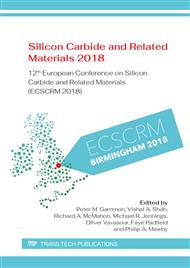p.184
p.189
p.194
p.199
p.204
p.208
p.213
p.217
p.222
Theory of Carbon-Vacancy Diffusion at the SiO2/4H-SiC Interface
Abstract:
Experimental data indicate that carbon vacancies incorporated in active regions of SiC devices are important electrical defects, responsible for device limiting effects such as carrier lifetime reduction. For field-effect transistors that include a 4H-SiC/SiO2 interface, such as at the gate, the oxidation pro- cess is understood to introduce native defects to the SiC, including injection of carbon self-interstitials and vacancies, that diffuse into the active layer and interact with other defects and impurities. It is therefore important to understand the migration behaviour of primary native defects such as VC in the vicinity of 4H-SiC/SiO2 interfaces. We report here the results of a density-functional theory investi- gation into the diffusion of the carbon vacancy in such a region. We conclude that the migration of VC is significantly hindered in the immediate vicinity of the interface, with the energy of diffusion barrier being approximately 15% greater than the corresponding diffusion in bulk 4H-SiC.
Info:
Periodical:
Pages:
204-207
Citation:
Online since:
July 2019
Authors:
Price:
Сopyright:
© 2019 Trans Tech Publications Ltd. All Rights Reserved
Share:
Citation:


